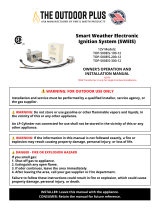
68-0160 14
•The gas control knob is hard to turn or push down.
•The gas control is likely to have operated for more than
200,000 cycles.
Operation
The VR8345 gas controls provide ON-OFF manual
control of gas flow. In the OFF position, pilot and/or main
burner gas flow is prevented. In the ON position, pilot and/
or main burner gas flow is under control of the thermostat,
the direct spark ignition (DSI) module, hot surface ignition
(HSI) module/intermittent pilot module, and the gas valve.
DIRECT SPARK IGNITION/HOT
SURFACE IGNITION APPLICATIONS
System Operation
When the thermostat calls for heat, the DSI OR HSI
module is energized. The module activates the first and
second automatic valves of the gas control, which allows
main burner gas flow. At the same time, the DSI/HSI
module generates a spark at the igniter-sensor to light the
main burner.
The second automatic valve diaphragm, controlled by
the servo pressure regulator, opens and adjusts gas flow as
long as the system is powered. The servo pressure regulator
monitors outlet pressure to provide an even main burner gas
flow. Loss of power (thermostat satisfied) de-energizes the
DSI/HSI module and closes the automatic valves. The
system is ready to return to normal service when power is
restored through the thermostat.
If the igniter-sensor stops detecting a flame at the main
burner, the trial for ignition is restarted. On DSI/HSI mod-
ules with lockout timers, the automatic valves are de-
energized and ignition stops after the lockout period. On
modules without lockout timers, the trial for ignition con-
tinues indefinitely and the first automatic valves remain
open.
If main burner flame is restarted successfully, operation
continues as described above. Gas control operation is
described in more detail below.
Valve Position During Thermostat OFF Cycle
The valve is positioned as shown in Fig. 13 when the:
•gas control knob is in the ON position.
•thermostat is not calling for heat.
The first automatic valve is closed. The second auto-
matic valve operator is de-energized, closing the channel to
the pressure regulator, and opening a channel to the under-
side of the second automatic valve diaphragm. The combi-
nation of spring pressure under the second automatic valve
diaphragm and lack of outlet pressure hold the diaphragm
firmly closed. Main burner gas flow is blocked by both
valves.
When Thermostat Calls for Heat
When the thermostat calls for heat, the DI module
generates a spark at the main burner and the first automatic
valve and second automatic valve operators are energized,
Fig. 14. The first automatic valve opens, and the second
automatic valve operator valve disk is lifted off its seat.
This diverts gas flow from the second automatic valve
diaphragm, and causes a reduction of pressure on the
underside of this diaphragm. The reduced pressure on the
bottom of the automatic valve diaphragm repositions the
diaphragm downward, away from the valve seat, allowing
main burner gas flow.
INTERMITTENT PILOT APPLICATIONS
System Operation
When the thermostat calls for heat, the S8600 Intermit-
tent Pilot Module is energized, The S8600, in turn, acti-
vates the first automatic valve of the gas control, allowing
pilot gas flow. Simultaneously, the S8600 module gener-
ates a spark at the igniter-sensor and lights the pilot. The
pilot flame is then sensed by the igniter-sensor, and spark
generation ends.
After the pilot is lit, the S8600 module energizes the
solenoid for the second automatic valve operator. (The first
automatic valve remains energized.)
The second automatic valve diaphragm, controlled by
servo pressure regulator, opens and adjusts main gas flow
as long as the system is powered and the pilot is burning.
The servo pressure regulator monitors outlet pressure to
provide an even main burner gas flow. Loss of power
(thermostat satisfied) de-energizes the S8600 module and
closes both automatic valves. The system is then ready for
the next cycle.
Loss of pilot flame, or when flame is too small to
reliably light the main burner, closes the second automatic
valve operator. The S8600 module then attempts to restart
the pilot. On S8600 modules with lockout timers, the first
automatic valve closes after the lockout period. On S8600
modules without lockout timers, the trial for ignition con-
tinues indefinitely and the first automatic valve remains
open.
If pilot flame is restarted successfully, main burner is
reopened, and gas flows to the main burner as described
above. Gas control operation is described in more detail
below.
Valve Position During Thermostat Off Cycle
The valve is poistioned as shown in Fig. 15 when the:
•manual gas control know is in the ON position.
•thermostat is not calling for heat.
The first automatic valve is closed. The second auto-
matic valve operator is de-energized, closing the channel to
the pressure regulator, and opening a channel to the under-
VR8345M
MAINTENANCE • OPERATION
The gas control should be replaced if:
•It does not perform properly during checkout or
troubleshooting.






















